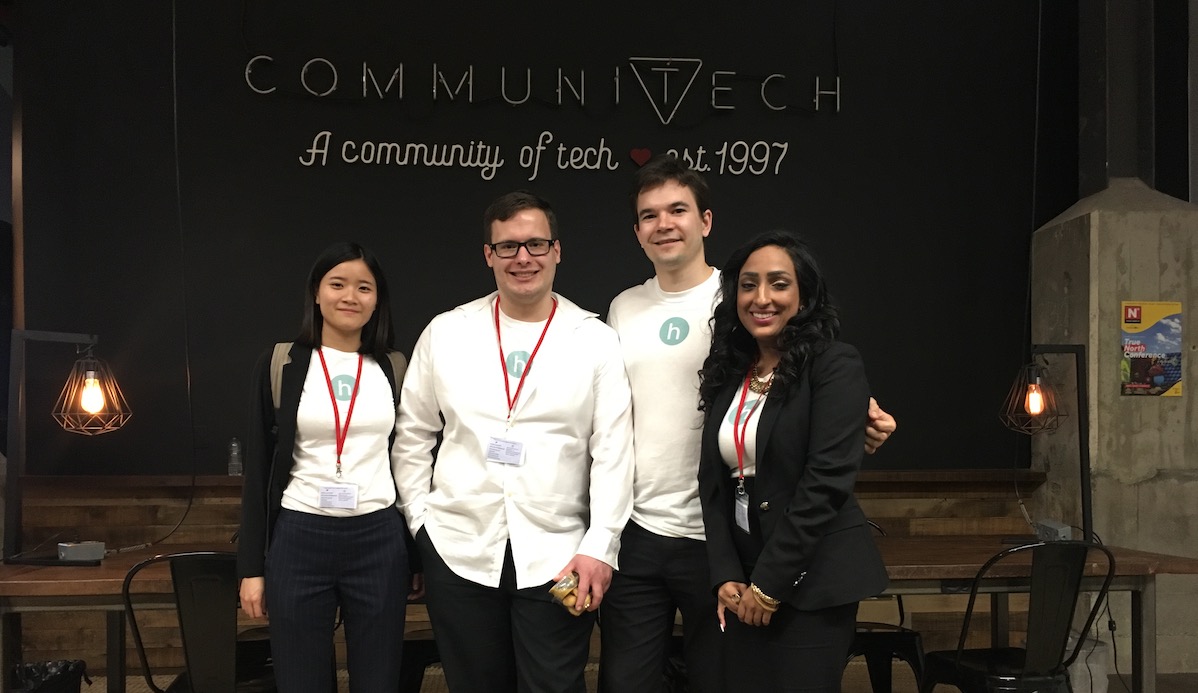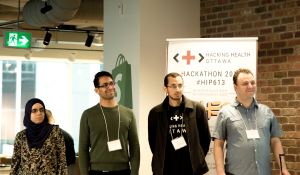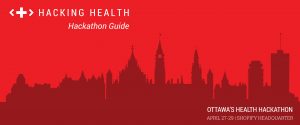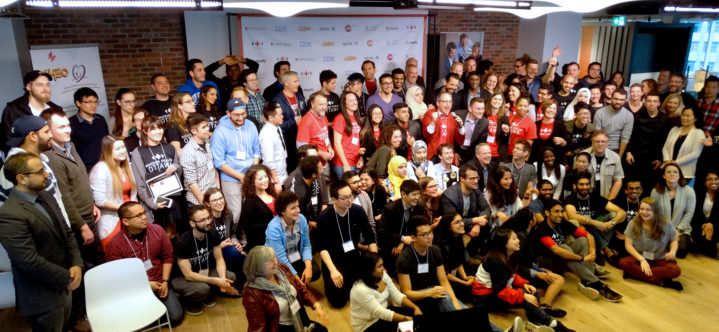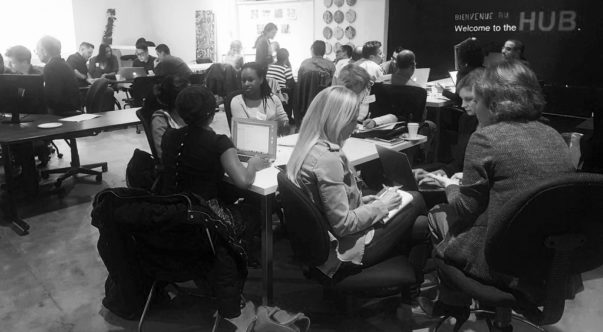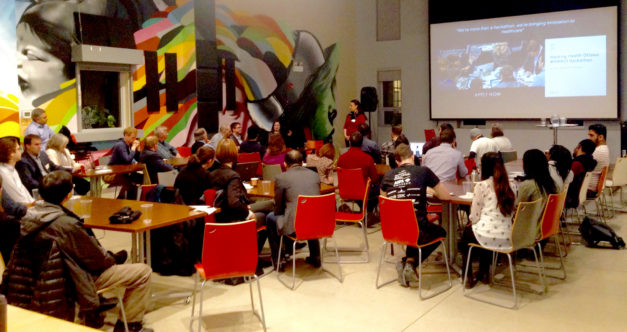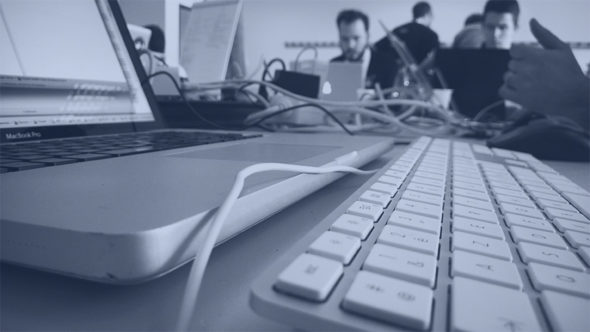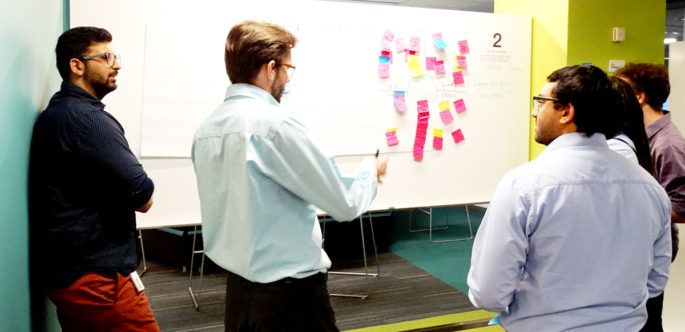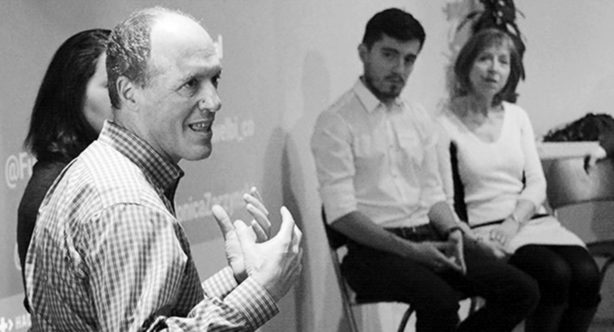The evening wrapped up with Haidee providing a breakdown of the Hackathon schedule, indicating that the pitches developed tonight would be useful on the Friday evening of the hackathon weekend. A networking session followed with members engaging in active and passionate conversation about their solutions and expressing enthusiasm for the impending Hackathon.
Ottawa
The Volunteer Factor
I joined the Hacking Health Ottawa (HHO) chapter in August 2016. I was working in health at the time and looking for new ways to bring together diverse stakeholders. I came across a post on Twitter about this thing called a Hackathon, and it was focused on health. I reached out to learn more and was invited to the chapter team meeting and a smaller event they had coming up. It was a great way to learn about Hacking Health, the people who make it all happen, and the work they do.
I came across a post on Twitter // I reached out to learn more
Throughout those first few weeks, I met students and professionals of all ages working in health, design, engineering, business, and government. The diversity of event participants was reflected in the make-up of the HHO team. The quality of speakers, engagement of participants and dedication of the chapter’s volunteers was inspiring. I still didn’t really understand what a developer did or how ‘ideation’ was different from ‘brainstorming,’ but it didn’t matter.
This was a learning journey, and it culminated in a three-day event each year called a hackathon, where a DJ is a must, energy is contagious, and people don’t want to leave (seriously…we had to kick people out at the end of each day).
There is always a moment during our events where someone realizes HHO is 100% powered by volunteers.
There is always a moment during our events where someone realizes HHO is 100% powered by volunteers. Even though we  thank and recognize our volunteers at the beginning and end of every event, it can often take folks a few events for it to really sink in. Their eyes light up, and they can’t believe it. You do all this in your spare time the say. Yes, we do. We work with amazing, dedicated people who show up, roll up their sleeves and make the impossible possible year over year. I can’t thank our team of volunteers enough for their generosity and commitment to HHO.
thank and recognize our volunteers at the beginning and end of every event, it can often take folks a few events for it to really sink in. Their eyes light up, and they can’t believe it. You do all this in your spare time the say. Yes, we do. We work with amazing, dedicated people who show up, roll up their sleeves and make the impossible possible year over year. I can’t thank our team of volunteers enough for their generosity and commitment to HHO.
As a volunteer myself, I have gained so much more than I have given. I have learned new skills, expanded my professional network, met so many talented people and been inspired by their stories of success and failure.
Never underestimate The Volunteer Factor. It lifts us up each and every day.
My learning journey continues, and I am grateful for all those who have and continue to make HHO a reality. The volunteers, the community, the health care partners and the sponsors. Thank you.
—-
Karine Dietrich is Partnership & Sponsorship Lead at the Ottawa Hacking Health chapter. She’s also Vice-President, Public Engagement and Knowledge Mobilization at Volunteer Canada, and owns a B.A. in Criminology with a concentration in law from the Carlton University.
Hacking Health Ottawa #HIP613 Hackathon
Schedule | What to Bring | Prizes & Awards | Judging Criteria
We invite healthcare professionals, designers, developers, innovators and entrepreneurs to take part in building useable solutions to frontline healthcare problems. Join us Friday, April 27 to Sunday, April 29 for Hacking Health Ottawa’s #HIP613 Hackathon taking place at Shopify.
What is #HIP613?
#HIP613 Hackathon is a fun, hands-on, intense, 3-day hackathon that breaks down barriers to healthcare innovation in Ottawa. Our goal isn’t just to organize hackathons, it’s to have a long-term impact on our healthcare system. Last year’s hackathon resulted in the development of 13 projects, two of which are being piloted at CHEO Hospital. We can’t wait to see you contribute to a hackathon project that can be brought to market for the benefit of communities everywhere – we have the resources to help you get there!
Schedule
| Friday, April 27 | Saturday, April 28 | Sunday, April 29 | |
| 8:00 AM | Breakfast | Breakfast | |
| 9:00 AM | Hacking Starts | Hacking | |
| 10:00 AM | Pitch Clinic with L-Spark | ||
| 12:00 PM | Lunch & Judging Criteria Presentation | Lunch | |
| 1:00 PM | Hacking | Hacking Ends | |
| 1:30 PM | Pre-Presentation: Team Line Up | ||
| 2:00 PM | Closing Ceremony | ||
| 5:00 PM | Dinner | End of Day 3 | |
| 6:00 PM | Hacking | ||
| 7:00 PM | Registration Opens | ||
| 7:25 PM | Opening Ceremony | ||
| 8:00 PM | Pitches | ||
| 9:00 PM | Team Formation & Networking | ||
| 10:00 PM | End of Day 1 | End of Day 2 |
Things To Bring
| ❏ Phone + Charger | ❏ Sensors/ Hardware |
| ❏ Headphones or Earplugs | ❏ Valid ID |
| ❏ Extra Battery | ❏ Notebook/ Pen |
| ❏ Extension Cords | ❏ Sweater |
| ❏ Keyboard/ Mouse | ❏ Computer and Modified External Monitor (optional) |
Prizes & Awards
Prizes
• IBM Design Mentorship Program | Design studio sessions, mentoring, and more
• Shopify Mentorship Program | 3 hours of mentorship over a 3 month period
• CHEO Pilot Opportunity | Advice, feedback and potential for piloting within CHEO hospital
• Algonquin College Aging Solution | Up to $10,000 to assist a project related to aging
Awards
• Desjardin Health Innovation | $500 cash prize
• Girls & Women In Technology, sponsored by Macadamian Technologies | $250 Girls Can Hack it!
Judging Criteria
| + IMPACTFUL • Importance of the problem tackled • Extent of the impact the solution can have |
+ REALISTIC • Demonstration of a working prototype • Elaborate design of solution |
| + QUALITY • Quality of the design, UI, etc • Usability for the target users • Fit the ecosystem of infrastructure |
+ INNOVATIVE • Quality of the design, UI, etc • Usability for the target users • Fit the ecosystem of infrastructure |
| + PROMISING • Can be adopted naturally and rapidly • Level of insights on the solution • If possible: Could become a real business |
+ WELL PRESENTED • Clear, succinct, inspiring • Understand the importance of the problem |
The Hacking Health Ottawa Hackathon
Written by Hacking Health Ottawa Volunteer Kevin Dick who joined a team and jumped into the trenches to give us a recap of his weekend. Originally published on HHOttawa’s blog on Medium.
The long anticipated Hacking Health Hackathon, hosted by Shopify, came and went in a blur. In the short two and a half days, ideas were pitched, expertise was shared, and prototypes developed with the common goal of improving the healthcare system.
In broad strokes, Friday brought together physicians, developers, politicians, and members of the health community from as far away as California to set the scene, with none other than Cofounder of the Hacking Health movement, Luc Sirois hyping up the participants in anticipation of (and throughout) the weekend. Saturday was an event-filled day with participants arriving at 8 a.m. and hacking well into the night. Sunday was a frenzy to bring projects to a close and judging of the final pitched ideas, each team vying for the prizes that could bring their prototype to the next level! From end-to-end, it was a resounding success full of camaraderie and competition, energy and euphoria, and of course: hacking and health!
Friday: The Official Kickoff!
With the close of business hours, most of Ottawa was eagerly anticipating the promised sunshine of the weekend. A different energy was stirring at 150 Elgin, home of Shopify and temporary home and workspace of over 150 hacking health participants through the highly anticipated Hacking Health Hackathon! A steady stream of physicians, developers, engineers, designers, politicians, media, and health enthusiast converged into the large bright space. As they mixed in together, some were reminiscing on the string of events leading up to this moment, others actively networking with one another and eager to learn what was in store for the next few days.
The event began with a number of prominent speakers addressing the assembly of participants. Most notably, Haidee Thanda, the Chapter Leader of Hacking Health Ottawa welcomed us and described the journey that had led to this point. The highly enthusiastic Global Hacking Health Cofounder, Luc Sirois, took the stage and operated as both Master of Ceremonies and hype man, drawing out the enthusiasm of the crowd. He explained how these types of events would come to define our moment in history and be part of the stories passed onto the next generations. Describing how in Canada, we are an example for healthcare around the world, Mr. Sirois emphasized that this success is the result of constant innovation and urged us all to continually push that cutting-edge fringe of healthcare technology forward. He explained that this is why Hackathons are so crucial:
“We cannot invent without learning!”
In bringing together experts from multiple disciplines, teams can share in unique perspectives and increased breadth and depth of knowledge. Mr. Sirois described how innovation in healthcare is necessary for the transformation of the institution; ensuring that is a dynamically growing entity.
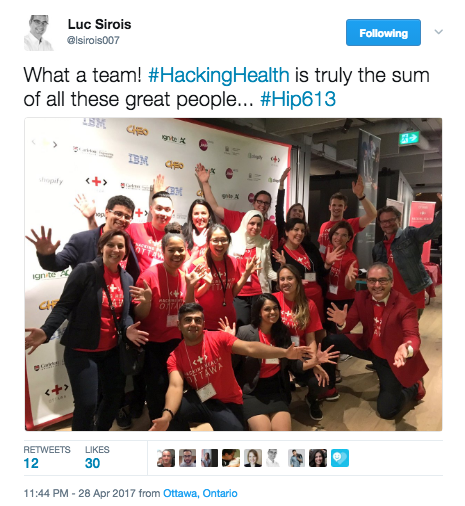
This idea was then built upon by the next speaker, Alex Munter, the CEO and President of the Children’s Hospital of Eastern Ontario and Ottawa Children’s Treatment Centre (CHEO-OCTC). He first described the history of CHEO-OCTC, explaining that there was significant resistance to establishing the institution with many claiming that Canadian healthcare was not sustainable.
“That would be true if your definition of ‘Sustainable” is ‘doing the same thing every year’!”
Mr. Munter explains that through the years, numerous allegations have been politically argued about the sustainability of the healthcare system and that the continual research and innovation has evolved the institution such that processes become more efficient. Ultimately, he states:
“Innovation is what drives the sustainability!”
Without innovation, the healthcare system would be in trouble and he therefore urged us all to pursue our passion to contribute to the health system. Concluding, he described his high expectations for the generation of millennials that will drive research and wished everyone good luck and that they enjoy themselves through the weekend.
Steven MacKinnon, the Member of Parliament for Gatineau then took the stage, offering the Federal perspective of innovation in healthcare. Explaining that healthcare consumes 40–50% of provincial budgets (outpacing inflation!) it is necessary that technology help produce increasingly efficient systems. He notes that the federal government recognizes this trend and that many efforts have been put forward to break down the barriers to information by opening access of data to the public.
Finally, Randy McCaig, Director of the Ottawa Desjardins Office and member of the Business Development team, congratulated us all for “being a little bit crazy!” Having experience in bringing successful hackathon projects to market, he commended all participants on their willingness to promote change in healthcare.
With that, the pitches started!
With about 25 different projects outlined on the Hacking Heath Sparkboard, each project lead had 60 seconds to pitch their idea with the intention of recruiting participants with the right skill-set. In a quick-fire manner, each idea was rapidly pitched in succession of the next. About halfway though, to keep energy high, we were all guided into a stretching routine and mandatory “Go Sens Go” chant while performing the wave.
With the final idea pitched, then came ‘The Match’, where participants ebbed and flowed throughout the room to pick the idea that they wished to commit to during the weekend. With clusters formed, each team found a secluded space to share in introductions and settle into deeper discussions of the problem faced and the approaches to resolve it.
Having been a part of the Sleep Apnea project leading up to the hackathon, I was one of twelve members committed to the project. Interestingly, team sizes varied from the very small (2–3 members) to the very large (8–12 members) with most fitting somewhere in the middle. Our team also appeared to comprise a disproportionately high number of machine learning aficionados. Certainly the skill-set within a team would help provide some context to the proposed solution; a particular challenge we faced was breaking out of our comfort zone and considering the problem from unique perspectives.
After several hours of discussion, we began converging on a weekend strategy and anticipated reuniting in the morning to begin bringing the pieces together! The teams slowly dissipated with an eagerness to tackle the problem in the morning!
Saturday: Hacking Commences!
Arriving as early as 8 a.m. and staying on well into the night (~11 p.m. kick out), Saturday was buzzing with energy. From dawn until dusk, it was somewhat magical to see ideas emerging as tangible prototypes in so short a time. With teams interspersed among one another, there was a congenial, yet competitive atmosphere. A broad range of mentors and experts were available for consulting on various aspects. From data visualization, to 3D printing services, to business model development, to sensor integration; there was help for any facets to each unique project!

Our team convened bright and early, and we rapidly brainstormed and refined a number of aspects of our proposed solution. The central problem we were addressing was the lack of information to support the diagnosis of a child’s sleep apnea, and current waitlists for a sleep study (which are often ineffective) can be upwards of two years. Our project leader, Dr. Matthew Bromwich, was eager to address any and all questions. Having a large team, we opted for a three-part solution:
· Engage: Parents suspecting that their child might have sleep apnea often come unprepared to consultancies with specialists. There are no resources for a concerned parent to consult which outline the various steps of information gathering about their child’s sleeping behaviours. In order to promote parent engagement, we decided to create a website (www.whatsapnea.com) which would outline the information a parent should bring to a consultation to facilitate the diagnosis of their child.
· Capture: Video footage of Sleep Apnea events make compelling evidence for diagnosis. We decided to create a sleep apnea video capture app to standardize the data collection process to amass evidence about a child’s sleeping behaviours. With a long-term goal of generating a night-long analysis system, the WhatsApnea app would allow parents to regularly collect video footage to help a physician with their diagnosis.
· Analyze: Using facial skin tone, we can extract heart rate from a patient in a contactless way. As part of the data analysis team, I sought to extract physiological information from patient videos to determine if we could detect sleep apnea events without the use of complex medical equipment. This machine learning layer would add significant value to the process of sleep apnea diagnosis as sleep apnea events could be automatically detected and provide a preliminary assessment to physicians.
As a biomedical engineering Master’s candidate with a passion for problem-solving, I reveled in the opportunity to engage with a physician on the front-lines of these medical system challenges. This is an opportunity rarely seen outside of a hackathon framework.
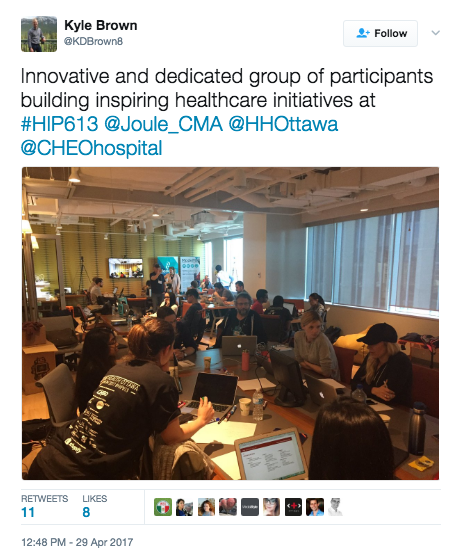
The Engage sub-team extensively used the IBM Design Mentors (Yasmine Taha and Peter Djeneralovic) to develop Empathy Maps and build a story around a proposed patient. This helped narrow down the scope of the problem to tangible targets. In general, whenever someone faced a particular roadblock, other team members were eager to find a way to circumvent it or mentors were available to provide expertise.
Ottawa’s own prototypeD experts were in-house offering a range of consultancy services including 3D printing and data visualization. My own work with the Analyze team necessitated the visualization of data streams in an interactive and dynamic manner. Janak Alford, Founder and CEO of prototypeD, helped me identify a number of packages to achieve what I envisioned.
This fully supportive and highly engaging atmosphere truly fostered individual and team creativity in the pursuit of healthcare solutions! To promote a healthy work environment, yoga sessions were also offered to help relieve tension and to reinvigorate the body after long periods in front of a computer.
Teams worked on late into the evening until the 10:30 p.m. kick out. Undoubtedly a number of teams would have carried on further into the early hours of the morning if they had the opportunity. For some that momentum transferred spatially from Shopify to their homes while others, temporally, from night to Sunday morning…
Sunday: Judgment Day!
The last day of the hackathon could be characterized by an altogether new flavor of anticipation: one that is sprinkled with anxiety and frenzy. The 3PM deadline was on everyone’s mind. Our team rapidly realized the importance of putting together a compelling presentation and we rapidly shifted gears from prototype development to pitch-craft!
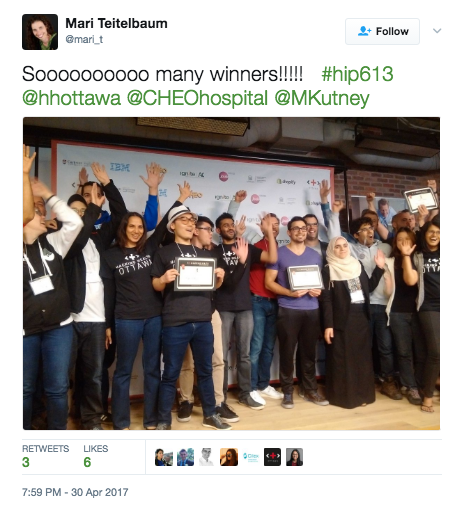
With a developer-heavy composition, our team lacked expertise in business model development. A panel of business-oriented mentors was available to help identify the value proposition to our three-part solution. Having scheduled one of the last appointments with them, this panel was a prized commodity in the frenzy of Pitch day.
How do you boil down the breadth of a problem and solution into a relatable, compelling, and investable presentation of a mere 180 seconds? We iterated our presentation over and over again until we converged on what we deemed the right flow. As one of the speakers, I was afforded a 20–30 second slot to convey the intricacies of our data analysis solution in a couple of sentences. One rapidly realizes that technical jargon must immediately be replaced with high-level concepts.
As the hours whittled away, you increasingly observed the shift toward pitch practice in the hallways and discrete workspace corners. Finally, the moment of truth arrived and all teams convened to the stage where a short ~40 hours ago the event had officially kicked off!
Each team took the stage and presented their problem and solution. Some creatively used a short skit to outline their issue; others relied on compelling visuals and videos. Common to all was the passion with which the project was delivered. A number of questions from the diverse panel of judges followed each presentation enabling the team to elaborate on their solution. It was clear that an incredible amount of effort had been put in by each of the teams and some had very promising approaches.
When the time came for deliberation by the judges, it was clear that the competition was incredibly close and teams eagerly anticipated the outcomes!
Here is the list of winners:
Prizes
CHEO Pilot Opportunity Prize
Sparkboard #59: Patient Wait Time
Sparkboard #2: Sleep Apnea Diagnostic Tool
IBM Watson Grand Prize
Sparkboard #46: Crowdsourcing Knowledge Synthesis in Medicine
Sparkboard #95: Canadian Pediatrics Hematology/Oncology Patient Database
IBM IoT Gold Prize
Sparkboard #47: A Smarter Post-operative Knee Brace
IBM IoT Silver Prize
Sparkboard #2: Sleep Apnea Diagnostic Tool
Joule Innovation Mentorship Prize
Sparkboard #75: Free Flap Monitoring
Shopify Mentorship Package
Sparkboard #91: Alrt Me
Sparkboard #47: A Smarter Post-operative Knee Brace
Sparkboard #73: VitalTracer
Impact Hub Ottawa Prize
Sparkboard #93: Timsle
Sparkboard #46: Crowdsourcing knowledge synthesis in medicine
Sparkboard #95: Canadian pediatrics hematology/oncology patient database
Designer Dream Team Prize, $5000
Sparkboard #47: A Smarter Post-operative Knee Brace
Sparkboard #80: Triage (MADD booking for Med)
Sparkboard #76: Better and Safer Critical Congenital Heart Disease (CCHD) Screening
Showcase Showdown Prize, $1000
Sparkboard #72: Take Care
Sparkboard #49: Latched
Awards
Desjardins Health Innovation Award
Sparkboard #84: WHIT: Women’s Health Information Tracker
Can Hack It! Sponsored by Macadamian – $250
Sparkboard #49: Latched
Sparkboard #84: WHIT: Women’s Health Information Tracker
Hacking Health Choice Award
Sparkboard #84: WHIT : Women’s Health Information Tracker
Best Solution for Healthcare Collaboration Award
Sparkboard #49: Latched
Best Solution for Patients Award
Sparkboard #91: AlrtMe
Best Health Education Solution Award
Sparkboard #85: Online Medical Publishing Platform
People’s Choice Award
Sparkboard #47: A Smarter Post-operative Knee Brace
With all said and done, Hacking Health Ottawa would again extend their thanks to all sponsors and who made this hackathon such a resounding success. Of course, this event is just another on the journey to implementing effective change in healthcare locally and globally.
Hacking Health Ottawa has a number of post-hackathon events in the weeks to come. Stay tuned for more info! Don’t want to miss a thing? Be sure to register for our newsletter or follow us on Twitter!
For more stories and articles about the success of the weekend, please see the following links:
[/banner]
HHOttawa: Pitch Clinic 101
Pitch Clinic 101
Originally published on HHOttawa’s blog on Medium.
Written by Hacking Health Ottawa Volunteer Kevin Dick
Who am I? What is my story/problem? What is my solution? How can you help? Summarizing each of these questions in a compelling pitch that draws in your audience in a short 60 seconds is no simple feat. The Hacking Health Ottawa Pitch Clinic on April 12, 2017 sought to mentor individuals and teams on the successful design, writing, and delivery of an idea pitch. As the final event prior to the highly anticipated Hackathon, there was a tangible sense of anticipation and excitement. For those interested in participating, be sure to check out the Sparkboard and sign up here!
James Chan kicked off the evening with an Impact Hub welcome, reminding us of the year old partnership with Hacking Health Ottawa and the exciting journey that has led to this point. Hacking Health Ottawa volunteers Karine and Haidee provided a breakdown of the night’s event, expressing thanks for L-Spark and Impact Hub for helping bring the event together.
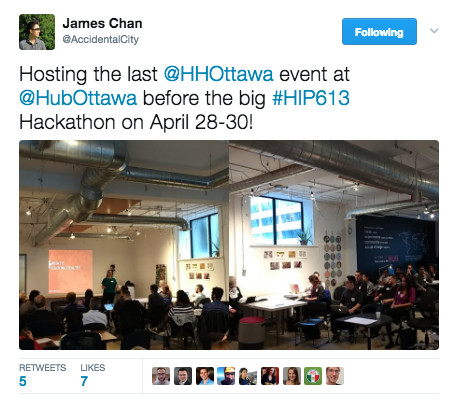
Before starting the workshop, Haidee prompted the audience: “What words or phrases would you use to describe Hacking Health?” A number of fitting phrases were offered including “innovation”, “partnership with CHEO”, and “diversity” and Haidee emphasized that the call to action was of principal importance as none of these initiatives could flourish without the dedicated time and effort of the growing community. She went on to introduce the Pitch Clinic facilitator for the evening: Elza Seregelyi from L-Spark with 25+ years of experience in the entrepreneurial space and having won several awards for innovation and impact.
In about a minute, Elza gave us a pitch centered on the story of Penny, an entrepreneur with big ideas but little expertise looking to build a community of innovators. In the short 70 second pitch, we were each of us drawn into the narrative and relating to the fictitious Penny in one form or another. Elza went on to describe the principal elements to a solid pitch so as to provide the audience with the broad strokes of an initiative.
Elza described many of the pitfalls faced by entrepreneurs giving a pitch. Often suffering of TMI (“Too Much Information”), a pitch is not a lecture nor is it the opportunity to share everything you know about something or anything to do with teaching knowledge. Rather, it is akin to a movie trailer, meant to entice the audience in a concise and compelling manner with a call-to-action to prompt subsequent engagement. Ultimately it is a short performance about you, the entrepreneur, but delivered specifically for your audience.
The three short steps to designing a pitch are summarized as:
1. Knowing your audience and what they care about
2. Knowing your objective
3. Connecting 1 to 2
Additionally, the core principles to be incorporated into a pitch are:
1. Grabbing the Audience’s Attention: Weaving a personalized story can leave an impression.
2. Inform: By being clear and concise (and avoiding jargon) the audience can take away meaningful bits from the pitch. A factual pitch lends credibility to the pitch and indicates impact of the initiative.
3. Motivate Action: A great pitch should incorporate an “Ask” where audience members can respond to the call-to-action in some form or another. Without this element, many pitches risk falling flat.
On a final note of advice, Elza described the critical need to emphasize the value proposition of a pitch which pertains to the “what is the solution?”, “what value does it bring?”, and the “who does it target?” It is important to realize that different stakeholders of a solution will respond to different facets of the value proposition. For example, a wearable medical device would bring certain value to a patient (e.g. receive better diagnosis), physician (e.g. leverage additional data for improved diagnosis), or manufacturer (e.g. diversification of products into different business verticals). Therefore the success of a pitch is centered on how well the narrative connects with the audience in attendance.
the critical need to emphasize the value proposition of a pitch which pertains to the “what is the solution?”, “what value does it bring?”, and the “who does it target?” It is important to realize that different stakeholders of a solution will respond to different facets of the value proposition. For example, a wearable medical device would bring certain value to a patient (e.g. receive better diagnosis), physician (e.g. leverage additional data for improved diagnosis), or manufacturer (e.g. diversification of products into different business verticals). Therefore the success of a pitch is centered on how well the narrative connects with the audience in attendance.
At this point, we broke into teams to hone our pitch writing and delivery skills. Some team members were meeting for the first time while others were already well acquainted with solutions in mind. It was fascinating to see how despite a wide distribution of team membership familiarity, each group could connect in meaningful ways to breakdown complicated concepts into short 60-second presentations. A number of co-facilitators circulated to help members hone their pitch crafting abilities. It is undoubtedly a process requiring multiple iterations and a multitude of perspectives to perfect.
Are you a developer, designer, policy analyst, artist or engaged citizen with a vested interest in healthcare? We invite you to get involved, and look forward to seeing everyone at the long anticipated hackathon in partnership with CHEO-OCTC, happening next weekend, April 28th to 30th!
Sign up here for the Hacking Health Ottawa newsletter and to stay up to date on all upcoming event details.
HHOttawa – A Panel on Startup Successes in Healthcare
A Panel on Startup Successes in Healthcare
Originally published on HHOttawa’s blog on Medium.
Written by Hacking Health Ottawa Volunteer Kevin Dick
What would an ex-military engineer, dentist, recent graduate, and industry professional have in common? Each has the profound desire to bring their healthcare vision to light in the hopes of helping the world. With experience of negotiating their way through the challenges of starting up their own healthcare companies, this diverse panel offered a number of insights into the world of startup in the healthcare field and kindly shared their expertise with the aspiring entrepreneurial enthusiasts in attendance.
On March 22nd, a congregation of Hacking Health enthusiasts, entrepreneurs, developers, and aspiring world-changers we were afforded quite a bit of “wiggle room” at the heart of Kivuto Solutions Inc., a software distribution company that specializes in hosted electronic software delivery. Vivek Raju, AVP Operations, warmly welcomed into this engaging space, with elaborate wall paintings, kitchenette, and even outfit with a central slide. Having been immersed in the tech communities of Ottawa for a number of years, he explained how Hacking Health Ottawa has added considerable value since its inception about two years ago.
Hacking Health’s Haidee and Karine kicked off the session reiterating the Hacking Health mission and its objective in bringing together individuals who might not normally collide in the day-by-day. Through these events, the ecosystem of health initiatives become increasingly enriched with expertise across a broad range of disciplines so as to bring together new ideas, new ways of thinking, and promote collaboration within a dedicated innovative space. This evening was one to inspire the successes of startups in the health space with talks from four entrepreneurs willing to share their experiences.
Our first panelist, Suzanne Grant, Cofounder and CEO at iBionics, is a serial entrepreneur with over 20 years of experience. Beginning her career in the armed forces, she intrinsically knew herself to be an entrepreneur and sought opportunities to develop solutions for those in greatest need, but did not know what exactly this would entail at the time. While on military tour in Rwanda during the 1994 genocide, she and her troops came across 900 orphaned children and she was struck with the innate desire to help in any way that she could. Calling her husband, she asked a question that would then introduce her into the Social Entrepreneurial space: “Can you send a blanket?” That one blanket would serve as a small kindness to a single child trapped in a darker place and time in the history of the world. Suzanne wondered about what would happen to the remaining 899 orphans and quickly drew the parallel between the abilities of the fortunate to help those in need and saw herself a facilitator in connecting the two. Within eight weeks, she succeeded in delivering over 18,000 kilograms of blankets and supplies to these children in greatest need by engaging a country with a heart set on helping. She explains that once she witnessed the success of this initiative, she could not stop.
Suzanne eventually moved to Qatar during its pre-cosmopolitan era, when it was emerging as a booming economy in the Middle East. With her technology and operations background from her time in the armed forces in addition to her recent entrepreneurial, successes she was poised to implement her vision at the intersection of social initiatives, publishing, and technology. She pioneered into the publishing domain in a country saturated in censorship, with initiatives like “Art of Business” and “Spirit of Empowerment” which sought to empower women in Qatar. Explaining how these efforts skirted the fringe of potential imprisonment due to their radical nature in a patriarchal society, she proudly describes the foundational change that it introduced in challenging the status quo of women in Qatar society.
Thereafter she turned her sights to tech with the goal of improving the quality of life for the blind. She described the iBionics Diamond Eye as a world-sensing interface over the retina to recreate vision for the blind. Requiring an implantable chip and a software layer, this work was only enabled due to the multi-disciplinary expertise of those involved.
She emphasized how neurotechnology has a high barrier to entry but is moving towards becoming a billion dollar industry and that they position themselves in the wireless transmission space. Envisioning an Apple-like approach where hardware will remain fixed and the company can then roll out improving software over time, she describes the aesthetic appeal to her solution as compared to other competitors. She explains that one of the biggest challenges the company faces is deciding between all the possible directions that they can take the company, given the plethora of options!
Dr. Marc Lamarre, Cofounder at Cumulus Dental, was the second speaker, wittily taking the floor with the apt observation that the speaker order was predestined from the proverbial saying “An eye for an eye, and a tooth for a tooth!”
A dentist with over 20 year of practical experience, Dr. Lamarre described the need for innovation in dentistry. One of his colleagues and mentors, Dr. Burton Siegel, had the first papers linking gum disease to heart disease, and subsequently discovered its correlation to an even broader number of health problems. This oral-systemic health link became the foundation of an entire body of research, however there existed fundamental limitations to the technologies currently used in the dentistry profession.
Dr. Lamarre described the history of the periodontometer: invented in 1880, used to measure the depth of gum, and has not been improved upon in the 130 years since. Dr. Lamarre wished to develop a new state-of-the-art technology by creating voice-activated charting system to then create a fully recreated three dimensional model for dental charting. With the hopes of pushing the field of dentistry from its current reactive state into a more proactive one, Cumulus Dental hopes to improve the ability for early detection of gum disease in patients with the hopes of preventing some of the system health problems now known to be associated.
“If you don’t have a fantastic team, it won’t work. In startups you work 24/7, but you will have the time of your life!”
The technology barriers faced by the Cumulus Dental team were tremendous since the field had very little in the way of software and community development. Intending to develop a handheld probe (to be released in 2018) as part of their solution framework, the team faces significant challenges in packing a large amount of functionality into a device no larger than current dentistry tools. Dr. Lamarre emphasizes money as the biggest barrier in addition to the need to a fantastic team of motivated individuals.
The third and youngest panelist Elizabeth Audette-Bourdeau, Cofounder and CEO at Welbi, already had the success of two initiatives behind her and now spearheading the third into the healthcare market. Elizabeth’s ambition for her talk was to convince the audience to turn their ideas into a viable business. Her motivation to establish Welbi was the result of a personal story involving the declining health of her grandparents and the severe lack in the ability to track their daily conditions. Frustrated about the lack in monitoring activity, she was inspired to resolve this problem herself and founded Welbi in 2016. Using existing wearable technologies such as a Fitbit®, Welbi can automatically track data about a loved one and learn about daily activity patterns so as to trigger a warning if ever someone appears suddenly outside of the norm (such as restless sleeping, changing heart rates, etc). This framework allows remote and improved resolution about the wellbeing of a loved one.
Elizabeth describes the journey to developing Welbi as a wholly unique experience. She urged that we all find our own path to developing our own startup, stating:
“There was no ‘Build your own Uber Startup’ book when Uber was first developing their company”.
She emphasized the need for focus as the startup environment can be fraught with distractions which threaten your efficacy as a team with a goal. Additionally, she provided examples about how the startup process is a highly dynamic space where one’s goals and focus will change through each stage of the company and that founders (i.e. “your family”) should be intrinsically self-reflective and selective about the decisions they make as each will impact the company in various ways.
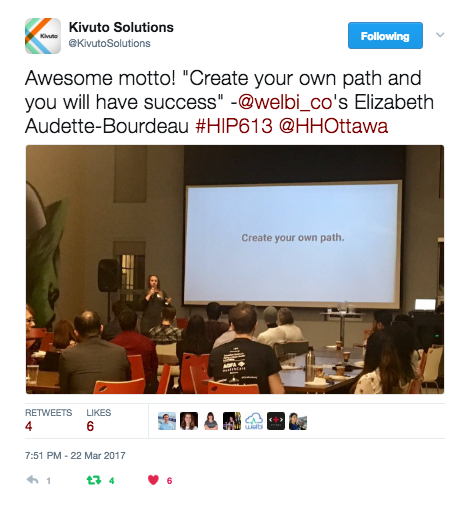
Our final panelist, Michel Paquet, Founder and CEO at Aetonix describes his pivotal moment to transition from being a “typical employee” to startup culture at a conference in Toronto upon hearing a talk by Canadian astronaut Chris Hadfield he describes as “a hugely passionate individual and excellent speaker”. Michel realized that he had more to offer to the world and trusted in his entrepreneurial calling. At the time his father was fighting cancer and his aunt had Alzheimer’s and he faced a similar situation to Elizabeth with her grandparents and struggled with the idea that no system for tracking the care of complex patients existed. Research shows that complex care patients represent a massive portion of the federal and provincial healthcare budgets and that any opportunity to reduce the readmission of complex care patients would alleviate a financial burden on healthcare systems. At the same time, a patient receiving equivalent quality of care at home would see improvement in their quality of life.
Mr. Paquet, through Aetonix, sought to develop a method to connect “care coordinators” in an intelligent way so as that a patient would receive the best possible care while remaining in the comforts of their own homes. As each has a dedicated “complex care plan” to adhere to, it is necessary for administrators of that care have a standardized framework to track the delivery of that care; cue the Aetonix solution.
Having personally faced the challenges of starting a company, Mr. Paquet offered a number of insights regarding finance (“This is intensive. It’s not a five minute job.”), success factors (“Get your product out, then find out how it is liked. Be ready to iterate and persevere.”), and partnerships (“Partnerships are key. Find your right partners that you work towards success together.”). On the topic of finding the right founders he explains that you need to surround yourself with the right people: “You go to war together, you go party together; these are the people who will lift you back up again.” Most notably, Mr. Paquet described the transition from stable employment to startup culture: “I had the oval office, boardrooms, and could fly anywhere while staying in nice hotels. I then went to working on a ping-pong table out of my basement. Which do I prefer? The latter, without a doubt!”

The panelists went on to answer a round of questions from the audience on topics such as the efficacy of networking and other topics critical to the establishment of startup success. Each synergized their answers based on the other’s, providing a comprehensive sense for the journey into and through startup culture while imparting a buzzing sense of excitement at the potential of bringing an idea to fruition. Thereafter, the congregation broke for generalized networking with that sense of excitement lingering in the air.
This panel set the stage for the exciting possibilities that will be enabled by the Hacking Health Hackathon with our anchor partner CHEO-OCTC! Are you a developer, designer, policy analyst, artist or engaged citizen with a vested interest in healthcare? We invite you to get involved, and look forward to seeing everyone again as we gear up and get ready for our April Hackathon.
Sign up here for the Hacking Health Ottawa newsletter and to stay up to date on all upcoming event details.
HH Ottawa IBM Bluemix Technical Workshop — Part 2
IBM Bluemix Technical Workshop — Part 2
Originally published on HHOttawa’s blog on Medium.
Written by Hacking Health Ottawa Volunteer Kevin Dick
Hacking Health Ottawa’s own Haidee and Mohamed kicked off the March 9th event with the inspirational Hacking Health video followed by the event road map leading up to the event. The next few weeks comprise a number of panels and workshops to keep teams engaged and on track on the road to the Hackathon!
This week’s workshop featured the return of Laura Alkhoury and the IBM team who kindly volunteer their time and expertise in teaching Hacking Health enthusiasts about different technologies. Laura began by briefly recapping the previous IBM Bluemix Workshop, indicating how today’s focus was on the remote acquisition of diverse sensor data. Polling the crowd revealed a majority of newcomers to the Bluemix platform. Today we were to learn about navigating a diversity of sensor data. There is a multitude of sensors and anything you might want to measure, you can find a sensor that would suit your need.
Today’s workshop used a single Raspberry Pi, setup with three types of sensors: a photoreceptor, pressure sensor, and flex sensor. Laura motivated the application of each in healthcare applications: a photoreceptor as a means of remotely detecting whether an individual enters an area, pressure sensors as a means of tactile sensing an environment (e.g. if a patient moves, or determining an individual’s pace while walking), and the stress receptor could be incorporated in various fabrics to determine how an individual moves or responds to different therapies. The innovations are endless and one might envision several ways of incorporating sensor arrays to acquire all types of data, however a stream of data is useless unless converted into information, and this was the theme of today’s workshop.
Peter Djeneralovic briefly explained the circuit setup and went into some details about how a sensor’s voltage is built up into capacitors and subsequently discharged at a given interval. This process can be varied based on the frequency with which you take readings: a higher rated capacitor would be used in cases where you take readings at longer intervals as charging the capacitor requires more time (perhaps useful to measure slow physiological processes life breathing) whereas a lower rated capacitor would be useful in cases at which high resolution readings within very small time intervals are ideal (perhaps useful in cases of very fast processes such as tracking eye movement).
Now conceptually primed, we were ready to jump into the code! Each of us connected to the Raspberry Pi and nano’ed into our own python scripts. Laura walked us through each line (no non-coder left behind!) explaining its purpose.
We chmod’ed the scripts to an executable form (“sudo chmod +x my_code.py”) and then ran it, passing in a numerical parameter as the GPIO pin number we wanted to acquire data from.
It was exciting to see the stream of values from the flex receptor pouring. The values generally hovered around ~160, however when Laura flexed the sensor, one could immediately see the values spike up to ~300. When increasingly flexed that value could rise to upwards of 500 until reaching a saturation limit, as defined in the sensor specifications.
 On the contrary, when streaming data from the pressure sensor, there was no “live” stream of data. Instead, one had to actually apply a pressure to the sensor in order to initiate the data stream. Interestingly, the harder one applied pressure, the SMALLER the value became up to a 20 lb limit (according to the sensor specifications) at which point the sensor streamed a value of 0. Increasingly lighter pressures would result in spiking values at times reaching the value of thousands at a feather’s touch.
On the contrary, when streaming data from the pressure sensor, there was no “live” stream of data. Instead, one had to actually apply a pressure to the sensor in order to initiate the data stream. Interestingly, the harder one applied pressure, the SMALLER the value became up to a 20 lb limit (according to the sensor specifications) at which point the sensor streamed a value of 0. Increasingly lighter pressures would result in spiking values at times reaching the value of thousands at a feather’s touch.
To reiterate the take home message: this data is meaningless unless it can be processed and analyzed to generate meaningful information. Even getting a sense of the variation and noise in the data stream was difficult without some means of graphing the data. Unfortunately, the Raspberry Pi was not outfitted with any large graphical packages; cue creativity!
To hack together a semblance of a graph to generate a sense of variation in the data I thought to convert the numerical value into an array index to symbolically represent that information in a more intuitive context than a simple value. This would allow one to interpret trends in the data.
Since the values were generally within the range of [0,300], I initialized an array of 300 underscore symbols: [_,_,_,…,_,_,_] . When joined together as a string and printed, this would give a straight horizontal line across the screen. I could then replace a single index of that array corresponding to my sensor value with another symbol, such as an asterix. For a value of 160, this would result in a complete array of underscores of size 300 save for the 160th position which would have an asterix.
When launching this modified script, I suddenly saw a vertical streaming graph:
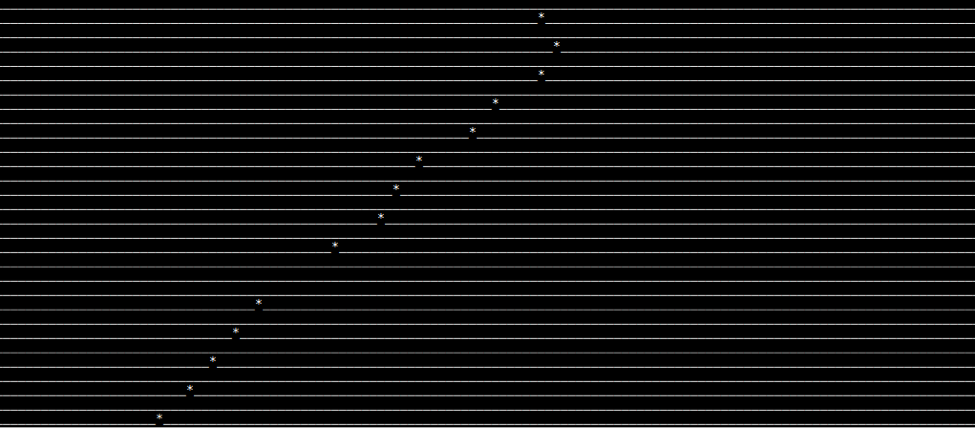
Now playing with the sensors really provided an intuitive interpretation of the changing sensor values.
I began to think about the types of sensors which might be useful to establish a new process to diagnose sleep apnea? How sensitive might these sensors need to be? How does one account for noise in the data stream? From the previous Design Thinking worshops our ideation sessions promoted the primary objective to develop some technology to enable remote diagnosis. This means defining the right set of sensors, but not only retrieve the data, but to convert that raw data stream into something meaningful. That information could then be used to establish when a sleeper had “normal” breathing patterns versus one experiencing sleep apena symptoms. This would amount to establishing certain thresholds in the data, so if the values were within a certain range for a certain period of time an alarm might be triggered to inform medical specialist about the potential breathing interruption during sleep. To motivate this idea, I came up with a bit of a game using the new graphing technique I had implemented.
By setting a vertical “boundary” on my graph at the 100th and 200th position, I made a game out of the sensor. If the sensor value was below 100, or above 200, the player’s score would remain at zero. However, if the player could keep the sensor value between 100 and 200, their “score” would increment. The challenge became a matter of keeping a very fine touch on the pressure sensor to try and achieve the highest score possible.

Here is an example of a player winning the game by applying a “Goldilock’s pressure”: not too high and not too low. This could potentially apply to a sleep apnea patient: shallow breathing patterns might correspond to light sleep, deep breathing patterns corresponding to deep sleeping patterns, but perhaps too much time spent between light and deep sleep patterns might correspond to a phenomenon seen in sleep apnea patients. If that Goldilock’s period reached a critical threshold, say 100, this could be some evidence for sleep apnea symptoms in a patient. A medical specialist might be alerted about this occurrence and a potential diagnosis reached from this evidence.

This data offers a number of exciting possibilities, particularly if a machine learning layer could be implemented to analyze this data stream. Everyone enjoyed the learning process and found great utility in this workshop; it established the technological foundation for many ideas churning in anticipation of the upcoming April Hackathon!
Applications for the Hackathon are open! Should your team develop the winning solution, you will have the unique opportunity to implement your project in conjunction with teams at CHEO-OCTC, turning your conceptualized project into actionable change in the world. There is already huge demand so if you are reading this now, take a moment to register here.
Are you a developer, designer, policy analyst, artist, or engaged citizen with a vested interest in healthcare? We invite you to get involved, and look forward to seeing everyone again as we gear up and get ready for our Hackathon with our anchor partner CHEO-OCTC.
Sign up here for the Hacking Health Ottawa newsletter and to stay up to date on all upcoming event details.
HH Ottawa IBM Bluemix Technical Workshop
IBM Bluemix Technical Workshop
Originally published on HHOttawa’s blog on Medium.
Written by Hacking Health Ottawa Volunteers Jinu Kurian and Kevin Dick
The Hacking Health initiative is aimed at bringing together change-makers across disciplines, enable them to engage, learn, and grow together, and support the pursuit of innovation in healthcare. With an increasingly tight-knit network of Ottawa healthcare enthusiasts, the time is ripe to transition into the learning phase. With Platinum Partner IBM kindly providing their space and expertise, we assembled and settled in the IBM Ottawa building, armed both with laptop and burning curiosity.
Jim Boland of the IBM Analytics Division motivated us with a presentation on the space occupied by the “Internet of Things” (IoT) in the future, notably on its application to wearable technologies on February 23, 2017 at IBM. IoT promises to compliment the propensity of smartphones in modern society, creating a future where we are increasingly connected and immersed in our surroundings. Promising a number of unique inventions (imagine “smart shoes” that relay directions as your walk around!) healthcare solutions could greatly benefit from the integration of IoT in its existing framework. Sensor data could be collected from a multitude of sources, and from anywhere in the world, the role of Analytics is to take all of that data and turn it into meaningful information. In the pursuit of our own solutions to problems, we were prompted to consider this approach in the context of healthcare.
Turning tale into intuition, we transitioned into the hands-on portion of the workshop. With a number of Raspberry Pis at our disposal, we were guided through the process of interfacing with the small boards and connecting to the IBM Bluemix Cloud. Laura Alkhoury and Peter Djeneralovic were the Bluemix gurus leading us through the workshop; altogether we had a small army of IBMers facilitating the smooth execution of the workshop and eager to address any questions. By the end of the night, the participants had a sense of how to set up a simple flow on Node-RED, a visual editor for “wiring the Internet of Things”. In the end, temperature readings were obtained from the Raspberry Pi devices at five second intervals, and the data was plotted with real-time updates.
Kevin Dick: “Reflecting on the previous experience at the IBM Design Thinking Workshop, I envisioned a number of ways IoT could enable the recording of sleep data for the purposes of child sleep apnea diagnosis. The engineer within me excitedly thought of sampling rates, biometric analysis, and machine learning signal classification. The designer within me considered the opportunities for physicians and clinicians to have access to a real-time stream of patient data, accessible in the comforts of their office with the child in the comforts of their own bed. The entrepreneur within me envisioned the marketability of such a technology and believed in the relief such a technology might bring to child patient and child patient parent alike.”
Jinu Kurian: “Our group’s initial intent was to design an application to diagnose and monitor vestibular ocular dysfunction following a concussion. However, as the night at the Design Thinking Workshop progressed, we were slowly realizing more wholesome solutions to evaluate the individual patient condition and provide personalized care accordingly. One of the foreseen challenges with these designs is collecting, processing, and analyzing heavy amounts of real-time data for automated assessment within relatively short time periods. After attending IBM’s Bluemix workshop, I was beginning to see how this could be a problem made simpler. Suddenly, the ambitious goal of being able to simultaneously track a child patient’s biometrics, progression of ocular dysfunction and providing appropriate healthcare feedback, seemed one step closer to concreting into reality.”
The Design Thinking Workshop helped identify problems with existing healthcare technologies. One of the major and repeated concerns clinicians have voiced is the inability to monitor patients’ conditions after treatment or diagnosis at the hospital or clinic. A reliable method to track individuals’ progress from the care of their own homes, is amongst the most sought-after technologies that is still under development today. This is where the potential behind the IoT and Machine-to-Machine (M2M) can be harnessed, allowing data to be readily accessible and analyzed from almost anywhere!
Excited about this technology and want to try it out for yourself? For anyone who is interested in connecting up their own Raspberry Pi to Bluemix with Node-RED, there is a tutorial video and other resources available here.
This journey into the Cloud is only just taking off! This taste of IoT has each of us hungry for the second IBM Bluemix session on Thursday, March 9th, 2017.
Are you a developer, designer, policy analyst, artist, or engaged citizen with a vested interest in healthcare? We invite you to get involved, and look forward to seeing everyone at our next event as we gear up and get ready for our Hackathon with our anchor partner CHEO-OCTC.
Sign up here for the Hacking Health Ottawa newsletter and to stay up to date on all upcoming event details.
HH Ottawa – Healthcare Design Thinking Workshop
Healthcare Design Thinking Workshop
Powered by IBM
Originally published on HHOttawa’s blog on Medium.
Written by Hacking Health Ottawa Volunteer Kevin Dick
On the road to the April hackathon, Hacking Health Ottawa’s recently joined Platinum Partner, IBM, kindly shared their space and expertise in the first of several workshops to provide technical familiarity with tools for implementing healthcare solutions. Nestled inside IBM’s building is an open and colorful space; design studio by day, innovation center by night.
With full capacity in attendance in the evening of February 1st, 2017, the resonant sound of a gong at the session’s start brought us all to anticipatory attention. Introducing the principles at the core of IBMs ‘design thinking’ methodology, Yasmine Taha described the user-centric approach to developing solutions. In the consideration of the patient perspective when innovating healthcare solutions, empathy is the scaffold underpinning the design and development process.
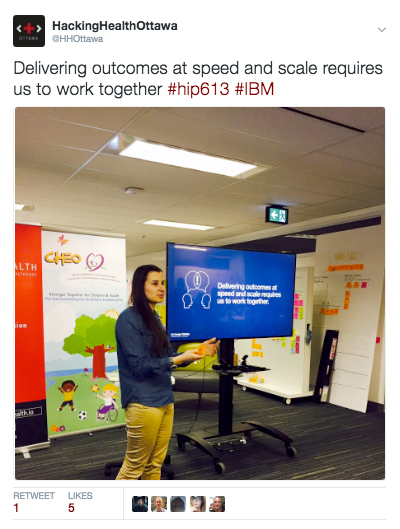 In the weeks and months leading up to the event, a number of problems have been outlined on the Hacking Health Ottawa Sparkboard allowing participants to join a team and connect with one another. Now meeting as team member for the first time, the multidisciplinary groups converged to their dedicated section of the room with an IBM design member to guide the design thinking process.
In the weeks and months leading up to the event, a number of problems have been outlined on the Hacking Health Ottawa Sparkboard allowing participants to join a team and connect with one another. Now meeting as team member for the first time, the multidisciplinary groups converged to their dedicated section of the room with an IBM design member to guide the design thinking process.
On the premise that users are multidimensional, we sought to develop a holistic understanding of their character, behaviors, and particularities. We were instructed to define a single user from the ecosystem of individuals affected by the current technologies; in our case, we defined Monica, an outgoing five year old with a love for stuffed animals. By illustrating what that user would think, say, feel, and do relative to the current solutions, we could build a formative representation of the advantages and disadvantages of existing frameworks. Armed with colored pads of post it notes, stickers, and pens, we freely contributed to that holistic view. Under the premise that “no idea is a bad idea”, we were free to explore any and all avenues of thought to paint this complex picture. Understandably it was a messy and inexact approach, however was remarkable effective at capturing the essence of the problems faced by our defined user.
Upon saturating our thoughts and considerations, we focused on clustering elements of similar nature, hoping to map our ideas to actionable solutions. This hierarchal clustering revealed some major themes at the heart of the problem. Participating in a session on the topic of Sleep Apnea, and more specifically on the development of new diagnostic techniques for children other than the current “gold standard” sleep test, we identified that ‘fear’ and ‘disruption of routine’ to be major factors impeding the compliance to the current technology. Grouped with a number of other engineers, we eventually converged on solutions that included outfitting stuffed animals with sensors to better detect sleeping biometrics. Exchanging thoughts with our lead physician, Dr. Matthew Bromwich from CHEO-OCTC, we determined that a home-care solution where a larger collection of lower quality recordings was preferable over the standard single session of recording high quality biometrics. Since that single session was often non-representative of typical sleeping patterns, our innovative solution had the potential of greatly improving compliance to sleep apnea diagnoses in children.
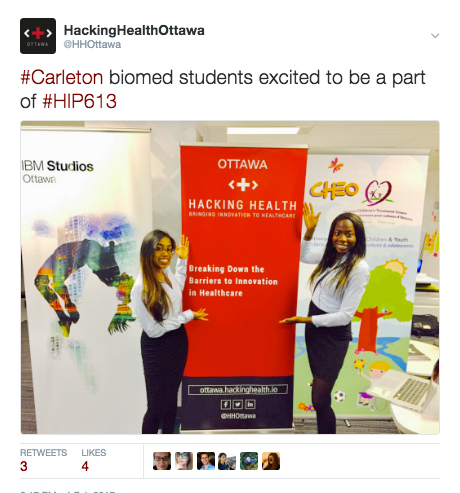 In the end, we were each of us satisfied with the outcome. A number of promising ideas were exchanged, reworked and iterated, and eventually finalized. Certain groups flew through the exercise while others wrestled with the multitude of directions to take a solution. It was fascinating to observe the diversity of perspectives and the group dynamics that broke a complex problem down to manageable concepts to eventually propose a novel solution. We were recommended to take each other’s contact information under the pretense that we could follow-up on the road to the hackathon.
In the end, we were each of us satisfied with the outcome. A number of promising ideas were exchanged, reworked and iterated, and eventually finalized. Certain groups flew through the exercise while others wrestled with the multitude of directions to take a solution. It was fascinating to observe the diversity of perspectives and the group dynamics that broke a complex problem down to manageable concepts to eventually propose a novel solution. We were recommended to take each other’s contact information under the pretense that we could follow-up on the road to the hackathon.
To conclude the workshop, Studio Director Kevin Grignon offered parting words on the significance of what was achieved in these short few hours. Briefly (and paraphrased), his words resonated with us:
“You all took an abstract problem and made something; by writing it down and putting it up on the wall, you made it real. Doing the work is the easy part, the thought that goes into the design is the hard part. You were each strangers and in the short span of three hours, you all came to a consensus and that is not a simple task. Solving problems as a group of people; you are driving progress forward through selflessness. Hacking Health is a passion play; it is about giving to the cause…”
When the gong rung at the session’s start, we were each of us strangers; struck again at session’s end, we were each of us acquainted and anticipating the next visit to IBM.
Starting with a bang! #Hackinghealth #HIP613 pic.twitter.com/H6lcOhfWvD
— HackingHealthOttawa (@HHOttawa) February 1, 2017
Are you a developer, designer, policy analyst, artist or engaged citizen with a vested interest in healthcare? We invite you to get involved, and look forward to seeing everyone at our next event, an IBM Bluemix workshop, as we gear up and get ready for our Hackathon.
Sign up for the Hacking Health Ottawa newsletter to stay up to date on all upcoming events.
HH Ottawa – Silo-tions for Healthcare: A Panel on Breaking down Silos in Modern Healthcare Systems
[banner class=”white”]
Silo-tions for Healthcare:
Panel on Breaking down Silos in Modern Healthcare Systems
Originally published on HHOttawa’s blog on Medium.
Written by Hacking Health Ottawa Volunteer Kevin Dick
Hacking Health Ottawa is at an exciting nexus! With the welcoming of two new collaborative partners, IBM and Carleton University (Faculty of Engineering and Design), we find ourselves at the bridge between the “Meet” and “Learn” phase on our route to the Ottawa Hackathon. A number of technical workshops to be hosted at IBM are on the horizon, promising to supplement innovative ideas with hands-on knowledge. To carry on the conversation and spark new inspirations, a panel discussion involving stakeholders across the healthcare industry was organized on January 11th, 2016 at Impact Hub Ottawa with a sold out crowd of healthcare enthusiasts in attendance.
On the theme of breaking down the silos in modern healthcare systems, the panel’s moderator, Adam Freed, opened with a three part definition of the term “Silo”:
“1. A tower or pit on a farm used to store grain
2. An underground chamber in which a guided missile is kept ready for firing
3. A system, process, department, etc. that operates in isolation from others”
Motivating the audience on anecdotes of the third definition, he challenged the attendees to reflect on the absence of interoperability in healthcare systems and to innovate solutions to break down these silos. Prompting us with suggestions of where this responsibility might lie, we considered governmental bodies, the industry sector (both large and small), policy makers, medical professionals, and patients themselves. Leveraging the expertise of a diverse panel to lend some insight into the problem, a broad range of topics were broached and unique perspectives shared. Notably, each panelist recounted personal stories rooted at the core of their decision to contribute to advances in healthcare.
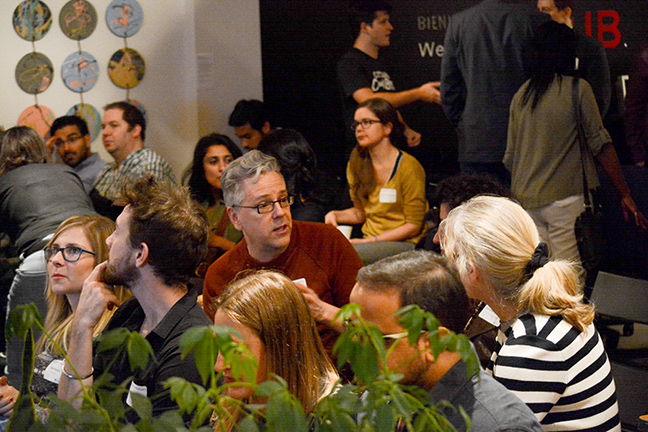
A sold out crowd of healthcare enthusiasts in attendance at the Health Innovation Panel.
From the front-line of medicine, Dr. Mark Dermer, a family physician in Ottawa self-identifies as a proponent for technological innovation and recounted numerous initiatives undertaken to incorporate impactful solutions in his many years of practice. He described the increasing need for open-minded and technology-centric cohorts of medical practitioners to be the first adopters of innovations in medical spaces.
With patients and tech users in mind, designer Monica Zaczynski from Telus Health described her experience in creating intuitive and user-friendly systems through the process of iterating a framework based on user feedback. Emphasizing the need for open channels of communication when working with a multidisciplinary team, her ideology embodies the essence of a silo-free healthcare system.
Representing the start-up space, Felipe Izquierdo the co-Founder of Welbi offered a perspective of challenging learning curves and uphill battles in the face of obstacles. The topic of breaking down silos in healthcare resonated with his experiences and he described certain freedoms in start-up culture to develop technologies that could “play nice” with others.
Reminding us all that improvements in health care need not be limited purely to digitalization, Jeannine Lafrenière the Founder and President of the Forget for a Moment Foundation offered a humanizing perspective and described the wealth of success and happiness generated from simple solutions such as introducing green spaces inside clinical environments. A strong believer in the power of individuals, she advocated for the voice of the crowd to kindle changes to policy.
When considering the challenges of general healthcare systems, “waiting lines” were an inevitable topic. The panelists discussed the critical demands of the healthcare systems and the audience became increasingly engaged. Topics such as “private vs. public”, industry competition, international healthcare models, and patient empathy are but some from a long list which flowed throughout the evening. Many opinions were shared and many were challenged allowing panelist and audience alike to dig into the roots of the problem.
 An interesting theme which emerged was the scale of the industry best suited to drive the development of interoperable healthcare systems. On one hand, larger corporations have financial freedom and an established influence facilitating the development and deployment of their technologies. However Monika notes that their dependence on legacy software and business constraints could limit the freedom necessary to create a user-friendly and future-facing frameworks. Contrarily, the start-up space offers such freedoms, though lacks the influence to establish their technology in a generalized public. Additionally, Felipe championed the idea that a small company’s close relations to their few clients was considered advantageous when compared to the client “out-of-touchness” of their larger contemporaries.
An interesting theme which emerged was the scale of the industry best suited to drive the development of interoperable healthcare systems. On one hand, larger corporations have financial freedom and an established influence facilitating the development and deployment of their technologies. However Monika notes that their dependence on legacy software and business constraints could limit the freedom necessary to create a user-friendly and future-facing frameworks. Contrarily, the start-up space offers such freedoms, though lacks the influence to establish their technology in a generalized public. Additionally, Felipe championed the idea that a small company’s close relations to their few clients was considered advantageous when compared to the client “out-of-touchness” of their larger contemporaries.
In the concluding remarks, the panel synthesis was the realization that no single “silver bullet” solution exists and that each stakeholder of the healthcare system, from patient, though industry, to government has a role to play in the gradual resolution of the current silo-suffering system.
Characteristic of the “Meet” phase of the Hacking Health timeline, a networking opportunity followed the panel, enabling the conversation to disseminate into the mingling of the crowd. In the anticipation of technical sessions on the horizon, the room buzzed in the excited exchange of ideas.
Are you a developer, designer, policy analyst, artist or engaged citizen with a vested interest in healthcare? We invite you to get involved, and look forward to seeing everyone at our next event, a Healthcare Design Thinking Workshop powered by IBM as we gear up and get ready for our hackathon with our anchor partner CHEO-OCTC.
Sign up for the Hacking Health Ottawa newsletter and to stay up to date on all upcoming event details.
[/banner]

